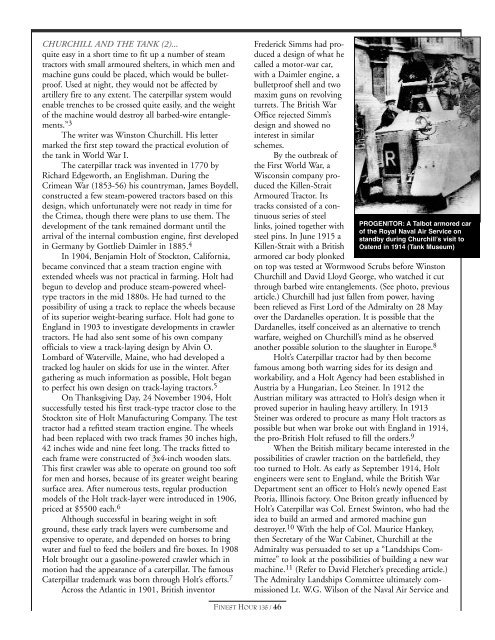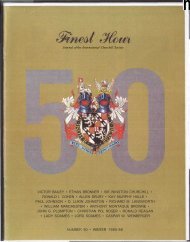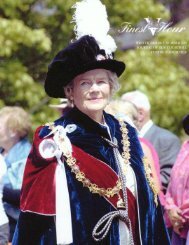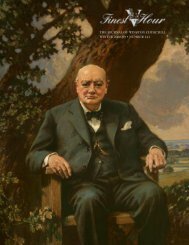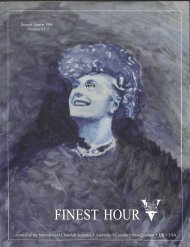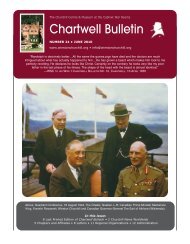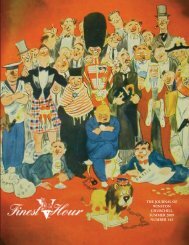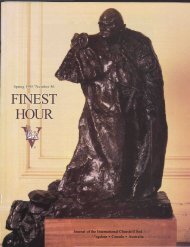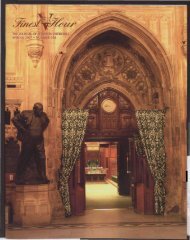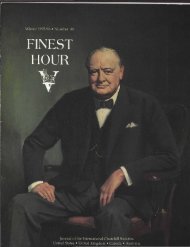CHURCHILL AND THE TANK (2)...quite easy in a short time to fit up a number of steamtractors with small armoured shelters, in which men andmachine guns could be placed, which would be bulletproof.Used at night, they would not be affected byartillery fire to any extent. The caterpillar system wouldenable trenches to be crossed quite easily, and the weightof the machine would destroy all barbed-wire entanglements.”3The writer was <strong>Winston</strong> <strong>Churchill</strong>. His lettermarked the first step toward the practical evolution ofthe tank in World War I.The caterpillar track was invented in 1770 byRichard Edgeworth, an Englishman. During theCrimean War (1853-56) his countryman, James Boydell,constructed a few steam-powered tractors based on thisdesign, which unfortunately were not ready in time forthe Crimea, though there were plans to use them. Thedevelopment of the tank remained dormant until thearrival of the internal combustion engine, first developedin Germany by Gottlieb Daimler in 1885. 4In 1904, Benjamin Holt of Stockton, California,became convinced that a steam traction engine withextended wheels was not practical in farming. Holt hadbegun to develop and produce steam-powered wheeltypetractors in the mid 1880s. He had turned to thepossibility of using a track to replace the wheels becauseof its superior weight-bearing surface. Holt had gone toEngland in 1903 to investigate developments in crawlertractors. He had also sent some of his own companyofficials to view a track-laying design by Alvin O.Lombard of Waterville, Maine, who had developed atracked log hauler on skids for use in the winter. Aftergathering as much information as possible, Holt beganto perfect his own design on track-laying tractors. 5On Thanksgiving Day, 24 November 1904, Holtsuccessfully tested his first track-type tractor close to theStockton site of Holt Manufacturing Company. The testtractor had a refitted steam traction engine. The wheelshad been replaced with two track frames 30 inches high,42 inches wide and nine feet long. The tracks fitted toeach frame were constructed of 3x4-inch wooden slats.This first crawler was able to operate on ground too softfor men and horses, because of its greater weight bearingsurface area. After numerous tests, regular productionmodels of the Holt track-layer were introduced in 1906,priced at $5500 each. 6Although successful in bearing weight in softground, these early track layers were cumbersome andexpensive to operate, and depended on horses to bringwater and fuel to feed the boilers and fire boxes. In 1908Holt brought out a gasoline-powered crawler which inmotion had the appearance of a caterpillar. The famousCaterpillar trademark was born through Holt’s efforts. 7Across the Atlantic in 1901, British inventorFrederick Simms had produceda design of what hecalled a motor-war car,with a Daimler engine, abulletproof shell and twomaxim guns on revolvingturrets. The British WarOffice rejected Simm’sdesign and showed nointerest in similarschemes.By the outbreak ofthe First World War, aWisconsin company producedthe Killen-StraitArmoured Tractor. Itstracks consisted of a continuousseries of steellinks, joined together withsteel pins. In June 1915 aKillen-Strait with a Britisharmored car body plonkedon top was tested at Wormwood Scrubs before <strong>Winston</strong><strong>Churchill</strong> and David Lloyd George, who watched it cutthrough barbed wire entanglements. (See photo, previousarticle.) <strong>Churchill</strong> had just fallen from power, havingbeen relieved as First Lord of the Admiralty on 28 Mayover the Dardanelles operation. It is possible that theDardanelles, itself conceived as an alternative to trenchwarfare, weighed on <strong>Churchill</strong>’s mind as he observedanother possible solution to the slaughter in Europe. 8Holt’s Caterpillar tractor had by then becomefamous among both warring sides for its design andworkability, and a Holt Agency had been established inAustria by a Hungarian, Leo Steiner. In 1912 theAustrian military was attracted to Holt’s design when itproved superior in hauling heavy artillery. In 1913Steiner was ordered to procure as many Holt tractors aspossible but when war broke out with England in 1914,the pro-British Holt refused to fill the orders. 9When the British military became interested in thepossibilities of crawler traction on the battlefield, theytoo turned to Holt. As early as September 1914, Holtengineers were sent to England, while the British WarDepartment sent an officer to Holt’s newly opened EastPeoria, Illinois factory. One Briton greatly influenced byHolt’s Caterpillar was Col. Ernest Swinton, who had theidea to build an armed and armored machine gundestroyer. 10 With the help of Col. Maurice Hankey,then Secretary of the War Cabinet, <strong>Churchill</strong> at theAdmiralty was persuaded to set up a “Landships Committee”to look at the possibilities of building a new warmachine. 11 (Refer to David Fletcher’s preceding article.)The Admiralty Landships Committee ultimately commissionedLt. W.G. Wilson of the Naval Air Service andPROGENITOR: A Talbot armored carof the Royal Naval Air Service onstandby during <strong>Churchill</strong>’s visit toOstend in 1914 (Tank Museum)FINEST HOUR 135 / 46
William Tritton of William Foster & Co. Ltd. ofLincoln to produce a small “landship.” Built in secrecy,the machine was given the code-name and referred to asa “water tank for Mesopotamia”—partly because of itsappearance, partly to keep its true nature secret. Thusthe name “tank.” 12Holt did not build tanks for Britain; those eventuallyproduced were of British production. But it was theHolt design and track laying caterpillar system, accordingto Swinton, that sparked the development of Britishtanks. 13On 20 January 1916 the first British tank began itstrials. More than a year earlier, <strong>Churchill</strong> had encouragedthe inventors and technical experts to work out aneffective design; when the War Office showed no interest,<strong>Churchill</strong> had found Admiralty money to fund theexperiments. He had also encouraged those whobelieved, as he did, that the tank could effectively endtrench warfare, substantially lessening the casualties inFrance and Flanders. 14Tanks were used for the first time in battle on theSomme, where a dramatic turn in the Entente (Allied)fortunes took place on 15 September 1916. Forty-ninetanks took part in the attack, moving forward on a widefront. Ten were hit by German artillery fire, nine brokedown with mechanical difficulties, and five failed toadvance. The rest advanced more than 2000 yards, capturingthe long-sought High-Wood, and three villages,Flers, Martinpuich, and Courcelette. But a disappointed<strong>Churchill</strong> wrote to Admiral Fisher, both of them nowout of power: “My poor ‘land battleships’ have been letoff prematurely and on a petty scale. In that idea residedone real victory.” 15<strong>Churchill</strong> had wanted to produce tanks in largenumbers, and only deploy them when as many as 1000were available. Recognizing the potential of the newweapon, British Commander General Haig asked theWar Office for a thousand. The Germans, fortunately,were far behind in their own tank experiments.As the tanks helped the British advance, RaymondAsquith, the Prime Minister’s son, was shot through thechest and died. Also wounded that day was the futurePrime Minister Harold Macmillan, who lived out his lifewith bullet fragments embedded in his pelvis, whichgave him a “shuffling walk.” During the day he waswounded, Macmillan recalled seeing a tank, one of“these strange objects,” bogged down in a shell-hole. 16The tank quickly proved its worth, even in smallnumbers. Eleven days after its first use, an attack by thirteentanks captured the village of Thiepval, which hadheld out since the first day of the Somme offensive. Thatsame day, Combles fell to an infantry attack supportedby two tanks, while at Gueudecourt, where tanks wereassisted by air reconnaissance, 500 Germans were takenprisoner with only five British casualties.The new invention was not without its problems.In muddy conditions tanks becamestuck and almost completely useless.Deployment methods and tank use in themilitary arts had not evolved very far, and to use them inthe wrong way would actually hinder a battle. TheFrench used tanks for the first time on 17 April 1917,when Gen. Nivelle planned to advance six miles usingtwenty divisions along a 25-mile front along the riverAisne. The attack was a disaster; his men halted afteronly six hundred yards. Expecting 15,000 casualties,Nivelle wound up with 100,000. Of the 128 tanks usedin the battle, thirty-two were knocked out on the firstday. Two villages in the battle zone, Nauroy andMoronvillers were totally destroyed. 17Far to the south and east in Palestine, meanwhile,the British launched their second attempt to captureGaza. Despite eight tanks, the use of gas shells, and atwo-to-one troop preponderance, this attack was a failure,but Gaza fell to Allenby’s troops on 1 November1917, the tanks doing everything that was expected ofthem despite harsh desert conditions.By mid-May 1917, Haig’s troops had made greateradvances than at any time since the start of trench warfaretwo and a half years earlier: 61 square miles ofGerman-held territory, over 20,000 prisoners of war, and252 heavy guns were taken in just over a month. Thetank had become an integral part of British infantry, andthe results were telling. The first German tank trial washeld only that month, on 14 May at Mainz, two daysbefore the renewed Battle of Arras ended. The Germanshad finally learned to appreciate this new weapon.On 10 August 1917, the British renewed the Ypresoffensive, but the advance was impeded four days laterby heavy rain. On the 16th the village of Langemarckwas taken, but a German counter-attack recovered muchof the gains. The initiative lay, however, with the British,who were helped in capturing the fortified German pillboxesby the use of tanks, and also by a ferocious Frenchdiversionary attack on the German lines at Verdun,when more than 5,000 Germans were taken prisoner.On 23 October along the Aisne, the Frenchlaunched a limited but sustained attack on German positionsdefending the Chemin des Dames, assisted byeighty French tanks. They advanced two miles across thepulverized terrain, taking 10,000 prisoners and deprivingthe enemy of an important observation point at Laffaux.Among the places captured by the French was the Fort dela Malmaison, a former fortress which had been soldbefore the war to a private builder, for use as a stonequarry. Known as the Battle of the Quarries, the victorywas what one historian has called “neat and compact andsatisfying as a gift package; indeed a gift to cheer a tiredand discouraged country.” The Germans, unwilling to >>FINEST HOUR 135 / 47


